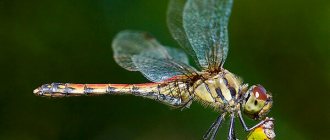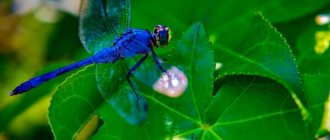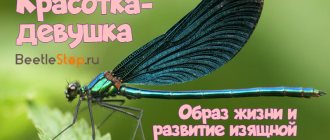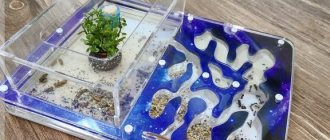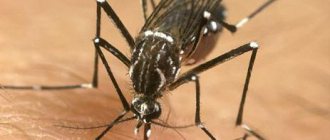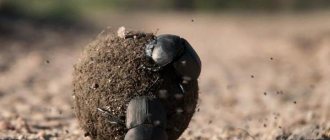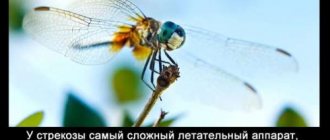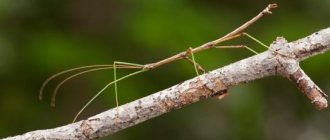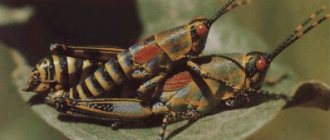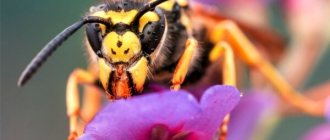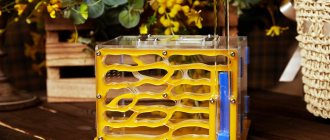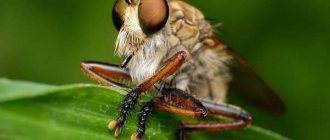The wasp is an arthropod insect from the order Hymenoptera, suborder - stalked belly. This is an amazing, interesting creature.
Its body is colored with transverse alternating yellow and black stripes, its length depends on the variety and is 2-3.5 cm.
The wasp has two pairs of wings on its back; they are connected, so if you don’t look closely, it seems that there are not four wings, but two.
There are many varieties of these insects; in addition to real wasps, there are also species such as sand wasps, glitter, scolia, road wasps, typhus, German, burrowing, flower, paper. Hornets are also wasps.
Wasps bite painfully, and getting their venom under the skin is fraught with swelling and serious allergies, but after a wasp sting, its sting does not remain in the wound, as happens after a bee sting.
Origin of the species
Insects have no specific scientific definition. Wasps include all stinging stalked bellies belonging to the order Hymenoptera. These insects are not classified as either ants or bees.
At the moment, there is a wide variety of wasp species. These include: road, sparkles, as well as scolias, paper, hornets and so on. All varieties are conditionally divided into:
- Single insects.
- Social insects.
Interesting fact: bees are able to defend themselves only with a sting, while wasps additionally use a powerful jaw apparatus. When in danger, wasps bite quite painfully.
Basin
Between the belly and chest the insect has a thin “waist”. In this way they fold the body almost in half.
They use this feature exclusively for hunting. They also use their sting to get food. This part of the body structure is the ovipositor. It is located at the end of the abdomen. Through it, poison is released, which is destructive for small victims and painful for humans. But wasps can also use their jaws to hunt.
Description
A wasp builds a nest.
Solitary wasps live separately. They personally build nests of strange shapes. All adult insects can reproduce. Nests are built in secluded corners: in spaces between walls, under roofs, in the soil. Only some species live without building nests. These wasps live in naturally created wood holes.
Social varieties live in large families. The nest is built by the queen, and not every adult insect can reproduce. In some cases, several thousand individuals live in such colonies, and only the queen can reproduce. Infertile wasps are classified as workers, while fertile ones are called queens.
Interesting fact : most Hymenoptera are able to change their lifestyle from solitary to social. This process is carried out in several stages.
Lifespan
Various representatives of the wasp family can live from a couple of months to several years. Species and external natural factors influence how long wasps live. Wasps are conventionally divided into solitary and social; their life spans are different.
Social ones live in a strict hierarchical system, like bees. Singles lead an isolated existence.
Uterus
The long-lived female among social wasps of all species lives for several years. All summer, the queen actively replenishes the population of the nest, continuously laying eggs. Towards the end of August, new, large cells for special offspring appear in the nest. From these cells young females and males hatch.
Appearance
Wasp with a sting
Wasps are extremely bright insects that attract the eye. They have a characteristic coloring - black and yellow transverse stripes. Adult insects grow up to 10 cm. Some females grow up to 18 cm. Small hairs are located along the body of the animal. The body ends with a sharp sting. The sting is short and smooth, which allows it to easily pierce the body of an enemy. The victims are able to move, so wasps sting in any position.
Wasp eyes
Insects have compound eyes. They are quite large compared to the body and can distinguish objects within a radius of 180 degrees. Three additional eyes are located on the top of the head. However, they are practically invisible to the naked eye. Whiskers are located near the small eyes. Their purpose varies depending on the insect's activity and certain situations. Wasps mainly rely on these antennae during flight. They serve as a guide for determining the direction of the wind, the size of the cracks, etc.
Interesting fact : since wasps have a smooth sting, they do not injure themselves when attacking.
Body structure
The body of a wasp consists of a head, torso, legs and wings.
The eyes have a special structure - they consist of a large number of plates - facets, this makes it possible to see simultaneously in all directions. The eyes are bulging and protrude above the head.
But besides these eyes, wasps have three more eyes, located at the top of their heads. It’s hard to believe that a wasp is so big-eyed, but you can easily be convinced of this by examining the wasp’s head in a close-up photo.
The wasp’s antennae are also a device for measuring cells when building a nest.Multifunctional antennae grow on the head - they are needed for smell and touch, the wasp uses them to detect air movement, and they also work as taste buds.
Only females have a sting - in females it plays the role of an ovipositor, and in case of danger, the insect uses it as a weapon - releasing poison through it into the body of its enemy.
Peculiarities
The name insects is a collective name for many species. The external characteristics of many wasp species differ significantly. The most common are: Paper wasps. The most familiar to people. They live near humans, standard black and yellow color. Sparkles. The wasps are medium-sized, growing up to 8 cm, and also have a standard color. Floral. These insects are extremely small. They do not grow larger than a centimeter. The color is standard with a predominance of yellow. German women. Insects with a specific color. Their body color is bright orange. Such wasps immediately catch the eye. Males are black and orange in color with black wings. Females are wingless, which is why they received the nickname velvet ants.
Habitat – where do wasps live?
Habitat of the common
wasp Animals can be found all over the planet. These insects have settled across all continents. They are available in all CIS countries, Europe, Africa, Asia and America. Insects cannot be found only in the vast expanses of the Sahara, in the Arctic, and also in the Arabian Peninsula. Insects like to settle in temperate climates. Hot and frosty regions do not allow wasps to survive.
Interesting fact : in the territory of the People's Republic of China and Japan there is an extremely dangerous species of these insects. Asian hornets grow up to 6 cm and can kill an adult with one bite. They are especially dangerous for allergy sufferers. Every year in these countries, up to 50 people die after being stung by this hornet.
Most insects are found in the northern hemisphere of the planet. Some are found in Brazil. Insects choose housing based on criteria: the presence of plants where they can hide, people and a temperate climate. Living near people allows wasps to get food faster. You can live in trees and build nests from wood. Some species build nests from clay or small stones. Externally, these houses look like small castles.
Interesting: Bear
